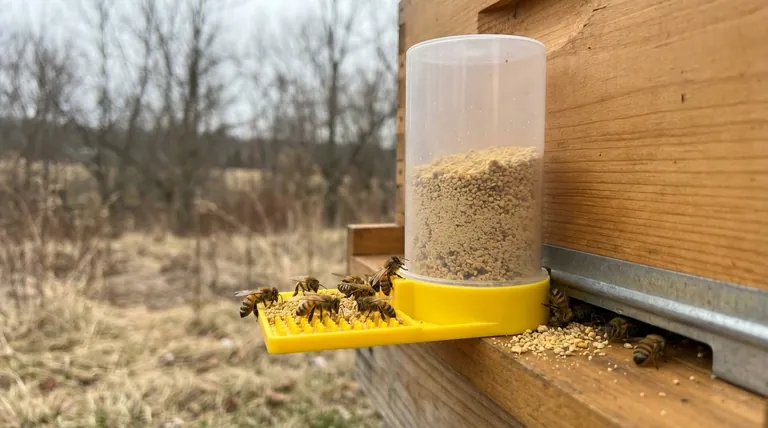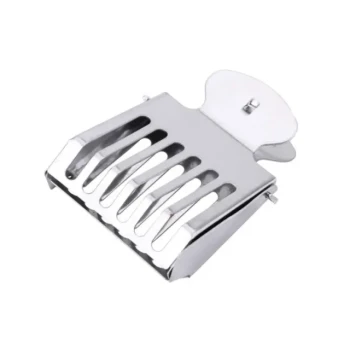Pollen substitute is primarily fed to honey bees during two critical periods: in the late winter or early spring to stimulate colony growth before natural resources become available, and any time a colony is located in an area with a severe lack of natural pollen. This supplemental feeding provides the essential protein bees need to raise brood and build a strong workforce.
The core purpose of feeding a pollen substitute is not just to provide food, but to strategically manage the hive's population cycle. It's a deliberate intervention to ensure the colony has the protein necessary to raise young bees precisely when natural forage is insufficient for their needs.

The Purpose: Fueling Colony Growth
Why Protein is Non-Negotiable
Pollen is the sole natural protein source for honey bees. Nurse bees consume it to produce royal jelly, which is used to feed the queen, larvae, and drones.
Without adequate protein, a queen may slow or completely stop laying eggs, leading to a rapid decline in the colony's population and health.
Bridging the "Pollen Gap"
A pollen gap, or dearth, occurs when bees have access to nectar (carbohydrates) but not enough diverse pollen (protein).
Feeding a pollen substitute bridges this gap, ensuring the brood-rearing cycle continues uninterrupted, which is vital for the hive's long-term survival and productivity.
Critical Feeding Windows
1. Early Spring Buildup
The most common time to feed pollen substitute is in late winter or very early spring, typically 4-6 weeks before the first natural pollen appears.
This encourages the queen to start laying eggs early, building a large forager workforce that is ready to capitalize on the main spring nectar flow when it begins.
2. Mid-Season Dearth
Beekeepers also feed during summer or fall if there is a sudden lack of natural pollen due to drought, agricultural patterns, or other environmental factors.
This prevents the colony from shrinking mid-season and ensures it remains strong and productive.
3. Pre-Winter Preparation
Some beekeepers provide pollen substitute 2-3 months before the first frost. This helps the colony raise a final generation of healthy, robust "winter bees."
These specialized bees have higher fat stores and are essential for helping the cluster survive the long, cold months ahead.
Understanding the Trade-offs and Risks
The Danger of Poor Timing
Timing is the most critical factor. Feeding pollen substitute too early in the season can create a large population of bees with nothing to forage for.
This can deplete the colony's honey stores and create an imbalance of nurse bees to foragers, straining the hive's resources.
Substitute vs. Natural Pollen
While natural pollen can be fed back to bees, it carries a significant risk of introducing diseases and pesticides if not from a highly reputable source.
For this reason, most beekeepers prefer commercial pollen substitutes, often made from soy or other proteins, which are safer and more cost-effective.
Attracting Unwanted Pests
Pollen patties placed inside a hive can attract pests like small hive beetles or wax moths, especially in weaker colonies that cannot effectively guard the patty. It's crucial to only provide as much as the bees can consume in a reasonable time.
How to Apply This to Your Goal
- If your primary focus is a strong start for the spring nectar flow: Begin feeding a pollen substitute 4-6 weeks before natural pollen is available in your area.
- If your primary focus is surviving a mid-season pollen shortage: Provide a substitute immediately upon noticing a lack of natural pollen to prevent a decline in brood rearing.
- If your primary focus is successful overwintering: Feed a substitute approximately 2-3 months before the first frost to ensure a healthy population of winter bees.
Ultimately, supplemental feeding is a powerful tool for ensuring your bees thrive when nature falls short.
Summary Table:
| Feeding Window | Primary Goal | Key Benefit |
|---|---|---|
| Early Spring (4-6 weeks before natural pollen) | Stimulate Brood Rearing | Builds a strong forager force for the main nectar flow. |
| Mid-Season (during a pollen dearth) | Prevent Population Decline | Maintains colony strength and productivity. |
| Late Summer / Early Fall (2-3 months before frost) | Raise Winter Bees | Produces robust bees with higher fat stores for winter survival. |
Ensure your apiary's success with strategic feeding. A strong, productive colony starts with the right supplies at the right time. HONESTBEE supplies commercial apiaries and beekeeping equipment distributors with high-quality, wholesale pollen substitutes and other essential beekeeping supplies. Let our expertise help you manage your hives for maximum health and honey production.
Contact HONESTBEE today to discuss your wholesale needs and optimize your feeding strategy.
Visual Guide

Related Products
- HONESTBEE Professional Entrance Bee Feeder Hive Nutrition Solution
- Brown Nicot Queen Cell Cups for Breeding Queen Bees Beekeeping
- Yellow Plastic Bucket Pail Perch for Beekeeping
- Economy Polyester Beekeeping Jacket with Veil and Hat
- Beekeeping Jacket with Hood and Veil for Beekeepers
People Also Ask
- How to make an entrance feeder for bees? A DIY Guide for Safe & Effective Feeding
- How does a bee entrance feeder work? A Simple Guide to Convenient Hive Feeding
- Are entrance feeders good for bees? Prioritize Hive Health Over Convenience
- What precautions should be taken when feeding bees inside the hive? Safeguard Your Colony from Robbing and Leaks
- What is the best feeder for bees? Choose the Right Feeder for Your Hive's Success



















